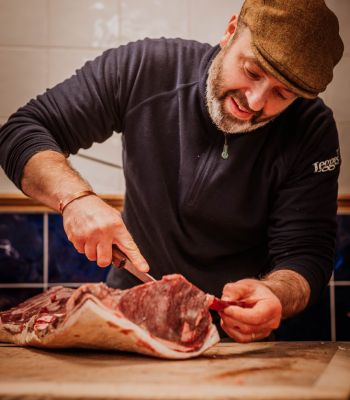Fifth-gen farm swaps dairy for 100% pasture-fed Herefords
26th November 2024
The Legge family moved away from dairy last year and responded to customer demand for 100% pasture-fed beef, which is sold in their farm shops.

Historically a dairy farm, challenges in the sector prompted Shortwood Farms to take a change of direction last year and begin stocking and rearing native breeds – mainly pedigree Herefords.
Fifth generation farmer James Legge said the small organic dairy business was being battered from all angles and when the time came to reinvest in equipment, they decided to take a different approach.
The Legge family, who have farmed the site since 1903, wanted to meet demand for 100% pasture-fed beef in their farm shops.
Good regrowth, healthy cows
They have chosen a herbal ley forage mob grazing farming system.
Once or twice a day, depending on conditions, the herd is moved to a different 10m strip of land and pasture is then left for 90 days to allow time for regeneration.
Although this is more labour intensive, James said the early indications are excellent.
“The regrowth we’re already seeing on the grass grazed is exciting, the cattle have never looked better, and the system is working extremely well.
“We plan to plant up to 100 species of grasses, legumes and herbs to ensure our beef is bursting with 100% pasture fed Herefordshire goodness.”

Tying in with SFI
The project has also tied in with the Sustainable Farming Incentive as they direct drilled some herbal leys this year, which offers payments under SAM3.
It was a fairly kind summer for establishing direct drilled seeds, James said. The farm’s heavy red clay soil tends to crack and resemble a “concrete road” in dry summers – but this year there were few prolonged periods of sunshine.
The cows are still outside and will probably come indoors in early December, depending on conditions, but they would like to outwinter them in the future – though this is a few years away.
First they need to build up the soil structure, James said.

While previously they reseeded around 20 acres a year to keep the grass leys young and maintain good yields for the dairy cows, they’re now looking to move away from that approach.
For example, direct drilling herbal leys to keep rejuvenating them, and building up the layer of organic matter on top.
Even this year, the first year of the project, the fields are not as wet underfoot as usual and carrying the cattle better, James noted.
The family are also bale grazing their small herd, making hay from older pastures at Shortwood Farms in the summer, which they then roll out for them in the autumn within the 10m strips.
Not only do the cows benefit from the extra nutrition, but the seeds within the bales help to naturally regenerate the soil.
It’s a system with few inputs besides making silage and hay and buying in a bit of straw.
READ MORE: BTV-3 impacts “extending far beyond animal health”
READ MORE: English beef and lamb standards have been compared with international competitors
A low input breed
Herefords were chosen as they fit in with the business’s low input approach – and the farm had always used a Hereford stock bull for the heifers.
Being located in Herefordshire, and with the breed being a good converter of grass, it seemed the natural choice for the family’s new venture.
Although the breed is slow growing, James said they are not concerned about this as the slow grown carcass is what they are aiming for.
Whilst most of the herd are pedigree Herefords, they also have a few Aberdeen Angus heifers in the fattening herd, plus a few Welsh Blacks and Angus crosses.
Looking to the future James said he’s inclined to go for Beef Shorthorns or South Devons.

100% pasture-fed beef
The family launched their 100% pasture-fed beef into their farm shops, Legges of Bromyard and Hereford, this month.
James’s father, Anthony Legge, who is a master butcher and owner of the shops, said:
“Only a few weeks ago, a customer who suffers from coeliac disease came in asking about our beef because they cannot eat meat containing any grain whatsoever.
“This is a crucial dietary need our family are proudly meeting head-on at home.”
Asked about the next steps for the farm, James said growing the herd and tailoring it to the type of carcass they want will be key – as well as, like many farming businesses, diversifying to bring in additional revenue streams.
Read more livestock news.


